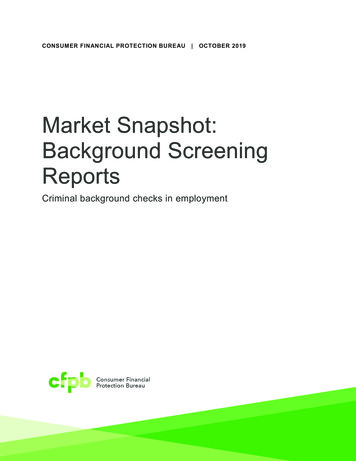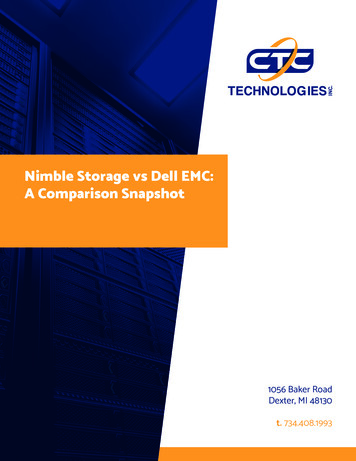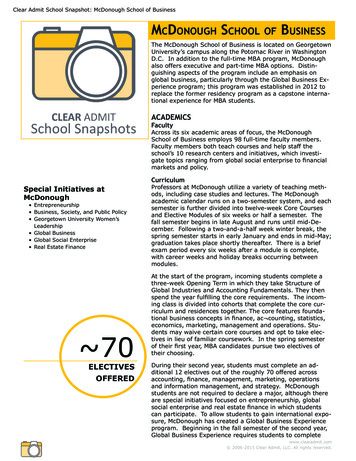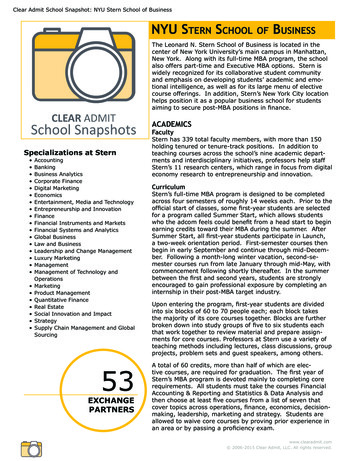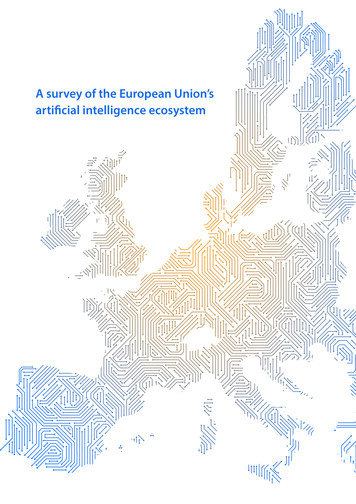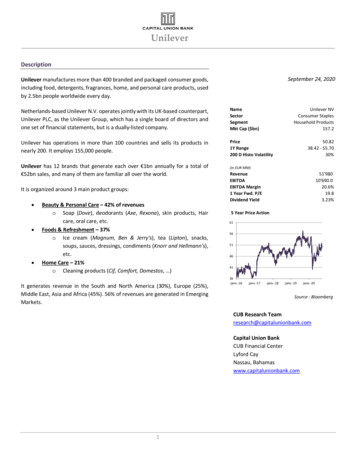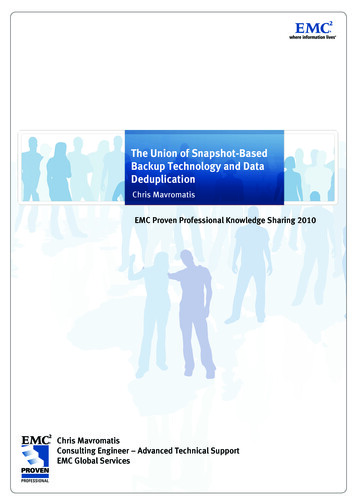
Transcription
The Union of Snapshot-BasedBackup Technology and DataDeduplicationChris MavromatisEMC Proven Professional Knowledge Sharing 2010Chris MavromatisConsulting Engineer – Advanced Technical SupportEMC Global Services
Table of ContentsScope . 3Tape vs. Disk . 3Array Based Data Protection. 4Array Backup Techniques . 4CoW Technique . 5Array Based Restore . 6Data Duplication . 7Best of Both Worlds . 8Solution Components . 9Backup Workflow . 9Configuration . 12Avamar Grid Configuration. 12CLARiiON Configuration . 14NetWorker Configuration. 18Performing a Backup. 27Performing Recovers . 30General Configuration Tips . 32Conclusion . 33Glossary . 34Disclaimer: The views, processes or methodologies published in this compilation are those of the authors. They do notnecessarily reflect EMC Corporation’s views, processes, or methodologies2010 EMC Proven Professional Knowledge Sharing2
ScopeThis article reviews some of the current issues behind tape technology as a method ofdata backup, and its replacement with disk based backup solutions. The main scope ofthis article is to illustrate how these disk based backup technologies can merge into asingle solution to provide the reliability of a seasoned backup enterprise softwareplatform, the snapshot based backup functionality of the EMC CLARiiON disk array, anddata deduplication from the Avamar data store.Tape vs. DiskDuring the past 15 years, tape backups have been the predominant tool for backup andrecovery operations. Tape solutions answered the call for backup challengessurrounding backup, recovery, and the proverbial “golden copy in the vault” for disasterrecovery. With the explosive data growth rates in today’s data centers, tape technologyand traditional backup software solutions are starting to plateau in their ability to achievedesignated backup windows and SLAs (Service Level Agreements). Granted, there havebeen improvements in data transfer rates in tape drive technology over the past severalyears, as you can see here:AIT-1-4MB/sDLT-8000 -6MB/sLTO-2-35MB/sLTO-4-120MB/sHowever, even with these improvements, when compared to a typical desktop hard driveof 0.5 Gbits/s, the performance characteristics become quite evident. High-end drivescan achieve sustained transfer rates of up to 1 Gbit/s.Backup-to-disk solutions not only provide fantastic transfer rates but the fact that tapedrive media has a linear data access method is another significant factor making disks asuperior media. During recovery scenarios, tape media commonly finds itself positioningto align to the location of the data on tape, whereas the disk drives’ intrinsic randomaccess characteristics lend themselves nicely to restore tasks.2010 EMC Proven Professional Knowledge Sharing3
Array Based Data ProtectionBeyond the basic backup-to-disk scenarios where backup software directs a data streamto a disk device, high-end disk arrays such as EMC CLARiiON or EMC Symmetrix expand the capacity plan of a disaster recovery solution, and enhance it to what is nowcommonly referred to as Business Continuity. Through advanced disk array capabilitiessuch as mirroring, Business Continuance Volumes (BCV), or Copy on Write (COW),these high-end disk arrays provide near-line storage capability such that when theoriginal data image is lost/damaged, businesses can continue to operate with zero, orminimal service interruption.Array Backup TechniquesSplit-mirror technique (STD – BCV)In split-mirror, or disk mirroring, every write request to the original data isautomatically duplicated to other mirrors or copies of that data. A mirror isredundant and is not a frozen image or snapshot. The mirror can be temporarilysuspended, or split, to create a snapshot. The disk subsystem temporarily stopsmaking updates to the mirrored copy; the data is frozen at that point.You can use the split-mirror for the backup process or other purposes. Mirrors create asnapshot of the data with the split capability. Unlike the CoW technique, a full data copyis available. This requires three copies of the volume to provide continuous processingfor backup. When the backup is complete, the mirror is resumed. In this setup, there areprimary and secondary real-time copies, and another PIT copy of the data.Using Symmetrix device mirroring for backups offers this key advantage: the backupof a static mirror-copy of the data rather than the production data itself. For example,databases need special handling to prepare for backup, either shutdown oronline backup mode. But, with mirroring, they need this special handling for only thebrief time that is needed to split the mirrors, not for the duration of the backup.During the backup, the database server can function normally using the productiondisks for the database.2010 EMC Proven Professional Knowledge Sharing4
CoW TechniqueWhen a backup is requested using the CoW technique, the disk subsystem creates asecond pointer, or a snapshot index, and represents it as a new, and full, copy. It is thesame to the user. The snapshot is created by saving the original data to a snapshotindex whenever data in the archetypal volume is updated. The snapshot processcreates an empty snapshot index, maintaining the original values that later changes inthe archetypal volume after creation. The snapshot is a combination of the archetypalvolume data with the snapshot index containing original data changed in thearchetypal volume.The CoW technique requires a fraction of the archetypal volume disk space. Averagesnapshot disk space requirements are 10 to 20 percent of the archetypalvolume space. The requirement depends on how long the snapshot is active and howmany writes are made to the archetypal volume (that is, snapshot index). CoW isefficient except in at heavy write environment or when the copy is required to be activefor a long time.CoW technique-based snapshots are good for impact-less backup operations because: Snapshot creation is quick when compared with split-mirror technique-basedsnapshots. Snapshots require less storage space than split-mirror technique snapshots,which require the same amount of storage space as the source volume.2010 EMC Proven Professional Knowledge Sharing5
CoW technology-based snapshots depend on the underlying storage space forrepository and cache and the archetypal volume combined, to present a particular PITview of the source volume. Repository and cache storage space is allocated at the timeof snapshot creation and, depending on the vendor's implementation, is fixed or can beexpanded. Load on repository and cache increases as more writes occur on the sourcevolume and may overrun the repository and cache storage space. Thesnapshot view is broken and the snapshot is rendered useless. Furthermore, whenmultiple snapshots exist for a given archetypal volume, large amounts of writeactivity can break all or some of the snapshots.Array Based RestoreDuring restore requests from backups taken from mirror snapshots, or Copy on Writesnapshots, the restore operation is internal to the disk array. In the case of STD – BCVmirror restores, users can sync the BCV back on the STD which results in data on theproduction STD to revert to the image in which the STD and BCV were split.In the case of CoW, you can perform restores so that the data on the source LUN(Logical Unit Number) can revert to its original image as of the time the snap sessionwas started. This is achieved by taking all of the write operations written to the snapreserve LUN pool, and applied back to the source LUN.Both of the restore operations provide restore capabilities based on the internal arraycapability to transfer data within itself. The restores are vastly faster then traditional taperestore methods where the data is read from sequential tape media and sent to theapplication server via an IP, SCSI, or SAN transfer pipe.Finally, another important advantage of disk array based backup and restore is that theyare both server-less and LAN free operations. Because the data movement is internal tothe disk array, these operations do not impose a load on the production data server. Thisis an important differentiating factor in a data centers’ backup strategy.2010 EMC Proven Professional Knowledge Sharing6
Data DuplicationThe game changer for disk based backupsCost is often the deciding factor for continuing to use tapes over disk based backupsolutions. Traditionally, disk based backup solutions have been more expensive thantape cartridges. As companies need to perform daily backups, the sheer amount of dataneeding protection is very large, thus making the mass storage capacity of tapecartridges less expensive than disk. Imagine for a moment that you have 10 users withan identical 100MB Word document on their PCs. During backup, all of these 10 files willbe backed up regardless of the fact that they are common to one another, and thus 1 GBof storage would be consumed on tape media.If any one of these users modifies their file, even one word within the document,traditional backup software to tape will result in making a backup of the entire 100MB fileall over again. Basically – regardless if a single byte or the entire file is modified, theentire file has to be backed up again. You can easily see how backups would requirelarge amounts of space on a weekly basis, thus making tape the most cost effectivebackup solution.Data deduplication is the game changing technology that allows businesses tosuccessfully deploy full disk based backup solutions.As the name suggests, the goal of data deduplication is to eliminate redundant data frombackups. With the appropriate client agents installed on the servers that are to bebacked up, data deduplication technology analyzes the 100MB file that is targeted forbackup at the source machine, and determines if the data is already known to thebackup server. If it is, the file does not need to be transmitted to the backup server, andthus the backup is now completed very quickly since the entire file does not need to besent over again. This workflow is true even if the machine that is doing the backup hasnot previously backed up this file. If another machine on the network has already backedup this 100MB Word file, then all machines on the data zone benefit from thededuplication.2010 EMC Proven Professional Knowledge Sharing7
In the above example, if a very small portion of the file was modified, the deduplicationsoftware would once again analyze the 100MB file, and determine that only a smallfraction of the file needs to be sent over to the backup server, thus making the backupprocess faster due to the time savings of not retransmitting the complete100MB file.The deduplication backup software keeps track of all of the machines and users thatperformed the backups, and manages the pointers that reference the original data, andall additional chunks from all backups taken. Data deduplication technology now makesdisk based backup solutions a very cost effective business proposition.Best of Both WorldsIt is now possible to merge these distinct backup methods of array based backups anddeduplication backups into a single solution that gives you the ability to benefit from bothdisk array features, and data deduplication technology. You can achieve this merge oftechnologies through the use of: NetWorker backup server PowerSnap application module Avamar data store CLARiiON disk arrayThis article assumes a minimal knowledge of each of the above technologies. We willfocus on the methods to merge these technologies. We will use the NetWorker backupserver as the main backup platform to maintain the backup configuration, schedule thebackups, and drive daily backup operations. Although NetWorker independently is notable to perform data deduplication, it is able to incorporate with an Avamar data gridwhich in turn has the main function of performing data deduplication.2010 EMC Proven Professional Knowledge Sharing8
EMC CLARiiON is the high-end disk array that will perform the snapshots of theproduction data using the previously mentioned CoW method. The bridge between theNetWorker backup software and the CLARiiON disk array is achieved throughPowerSnap. PowerSnap is an add-on module for the NetWorker backup server thatallows the backup server to integrate with the disk array, and thus drives the snapshotbased backup operations.Solution ComponentsPlease assume the following:Production server “as2” is a Windows 2003 server. It has access to a LUN which hasbeen provisioned from the CLARiiON disk array, and is mounted on drive letter W:\Proxy server “tito” is also a Windows 2003 server. Its primary purpose is to be the proxyhost that is going to mount the backup snapshot of W:\ onto itself, and validate thesnapshot operation. It is also responsible for sending a copy of the contents of W:\ to thebackup server for backup purposes.NetWorker backup server “ecc1” is a Windows 2003 server. Its role is to provide themain backup functionality on the data zone, integrate with both the CLARiiON disk arraythrough the usage of the add-on plug-in PowerSnap, and also integrate with the Avamargrid that is installed on the network.Avamar grid “avamar01-01” is a single node Avamar server. It will be the target for thededuplication data we are going to generate.Backup WorkflowDuring backups of the W:\drive of client as2, we configure NetWorker such that we willtake a PowerSnap backup of the data residing on this drive. Recall that W:\ is actually adrive which is a CLARiiON LUN, and for which we have configured Snapview (withinthe CLARiiON array) to perform a CoW snapshot.2010 EMC Proven Professional Knowledge Sharing9
At the start of the backup, the server as2 that contains the PowerSnap client softwarecommunicates with the CLARiiON array to start a Snapview session against the LUNW:\. This operation begins tracking the I/O change requests against the drive W:\internally within the CLARiiON array.Next, the proxy server “tito” tries to import the snapshot LUN (not the original) of W:\onto itself so that it can validate that the snapshot of the data was successfullyperformed. After the proxy server has imported the snapshot and validated the snapshot,it sends the contents to the Avamar grid in a deduplicated fashion.This is achieved by analyzing the data that is read off of the snapshot drive of W:\ andcomparing the data against the local cache database. This will determine if the file isalready saved (and not changed) from a previous backup attempt. If it needs to bebacked up again, this file will be opened, chunked into smaller pieces, and a hash idcalculated for that chunk of data.Next, the hash id is compared against a second local cache database to determine if thedata is already known to the Avamar grid. If a cache hit occurs, this portion of the filedata has already been backed up previously and does not need to be transmitted to theAvamar grid. If a cache miss occurs, a final lookup is performed again at the Avamargrid to determine if this data chunk has potentially been backed up previously fromanother client. If this lookup succeeds, the data does not need to be transmitted to theAvamar grid since the whole concept of data deduplication is to attain but a single copyof common data regardless of its origin. Avamar grid pointers will be updated to reflectthat this data chunk was saved for our client even though no data was actually sent, sothat during recovery the data will be sent back to the as2 server.This chunking, lookup, and data transmission process repeats until all of the data on thesnapshot drive has been analyzed and saved. Next, the proxy host deports the snapshotLUN, passes back to the application host as2, and sends a signal to the NetWorkerbackup server that the backup was completed.2010 EMC Proven Professional Knowledge Sharing10
Upon completion, we are left with a snapshot on the CLARiiON array that can be used inone of two ways.1. We can use this snapshot to once again mount it on the proxy host and performa file-by-file restore of select data.2. We can perform a “roll back” of the snapshot within the disk array itself (nothaving to mount any snapshots on any host), and quickly roll back the data at thepoint in time of the snapshot. This is the fastest way of restoring large amounts ofdata.Furthermore, we have the contents of W:\ protected off of the array, and onto theAvamar grid (through the use of NetWorker backup server) in a deduplicated fashion.This gives us the ability to restore all the data in the event that the array experiences acatastrophic failure. For an additional level of protection, the Avamar grid itself iscommonly replicated to a secondary Avamar server. It is imported to keep in mind thatthe backup process stated above is “server-free”, as all of the intense processing isperformed onto the proxy server tito and NOT on the application host as2. This makesthis backup solution a very lucrative proposition for production hosts that need minimalservice performance impact during the backup window.The first backup of the data which is deduplicated and sent to the Avamar grid does takelonger then the subsequent backups. This is because the first backup “seeds” the localcache files that would contain the references of the hash ids from the data which is to bebacked up. All subsequent backups would greatly benefit from a populated cache file asthe data would commonly be found to be a duplicate of previous backups, and thuswould not need to be re-transmitted to the Avamar grid.This is but just a single workflow scenario. It is possible to create snapshot backups thatrun several hours per day, leave the snapshot available for the restore onto theCLARiiON, and then send the data from the first/last/or all of these snapshot backups tothe Avamar grid in a deduplicated fashion.2010 EMC Proven Professional Knowledge Sharing11
ConfigurationAvamar Grid ConfigurationThe first step is to prepare the Avamar server for NetWorker backups. This can be
online backup mode. But, with mirroring, they need this special handling for only the brief time that is needed to split the mirrors, not for the duration of the backup. During the backup, the database server can function normally using the production disks for the database.

